Every day is more important the storage of information, but where do Google, Amazon or Apple among other companies store this information? They store them in data centers, which are huge buildings with servers that contain critical information for thousands of companies around the world. So the need arises to protect these physical servers against lightning strikes or power surges, hence this publication.
Due to this large increase in the production of electronic data, companies store their data in data centers. These data centers are built with elements that are sensitive to heat and electrical fluctuations. Methods to ensure high levels of speed, uptime and data handling capacity are intertwined in data centers through:
- Generating a power supply system with redundant generators to ensure servers are always on.
- Air conditioning systems to prevent fires and server failures.
- Grounding and surge protection systems to ensure that there is no loss of vital data.
Data loss in data centers can occur due to:
- Surges due to direct or indirect lightning strikes.
- Power outages and fluctuations
- Potential difference between different grounding components
Protection Measures for Data Centers
Installation of lightning arresters with PDC arresters
Nothing can stop lightning strikes during a thunderstorm, but installing an ADVANCE+ lightning arrester with a PDC arrester ensures an optimal level of protection, offering maximum safety to people and electrical installations. ADVANCE+ lightning arresters are the perfect solution for lightning protection, being able, through proper installation, to conduct all lightning energy safely to ground. In addition, all our lightning arresters have a limited lifetime warranty against manufacturing defects. The ADVANCE+ arrester is the best protection with the latest built-in technologies and the highest performance guarantee. This device has successfully passed tests based on UNE 21186, NFC 17102 and NP 4426 standards for arresters with arrester:
– SALT SPRAY AND SULFUROUS WET ATMOSPHERE.
– CURRENT TESTS (200kA – 10/350 µs)
– ADVANCE TIME IN PRIMING

As a result of the research conducted and the R&D projects developed, the ADVANCE+ lightning rod incorporates the following new technologies:
EAC – FEED FORWARD STABILIZATION IN IGNITION.
The dual energy block makes it possible to achieve a maximum deviation of 5% in the advance time based on product certification regulations.
DSF – FORCED BLOW DEIONIZATION
It allows the deionization by Venturi effect of the ionization dome, releasing a large quantity of hot air at the moment of lightning impact, expelling the carbon deposits caused by the deflagration.
AAA – WATER ISOLATION ASSURANCE
It allows to keep the PDC electrodes isolated, always maintaining their potential difference in extreme rain conditions due to electron displacement. By having a dual energy block, the charging of the main system is ensured.
AAE- ELECTRIC ARC ELONGATION
Avoids the deposition of highly conductive carbon on the PDC electrodes, maintaining their potential difference and avoiding self-discharge of the energy block.
ATMOSPHERIC DISCHARGE COUNTER
It is a measuring device that does not intervene in the operation of the protection system, but it is certainly recommended for all installations, since it is the only way to know that the system has suffered an impact and to know that we are protected. The ADT Counter counts and records the direct impacts and surges of a lightning protection system. Its design and materials make it robust, reliable and self-contained. It does not require external power supply and is compatible with any lightning arrester.

The ADT Counter lightning impact meter should be installed on the most direct down conductor to ground. The most common location is on the down conductor with the lowest ohmic resistance or the straightest or shortest down conductor.
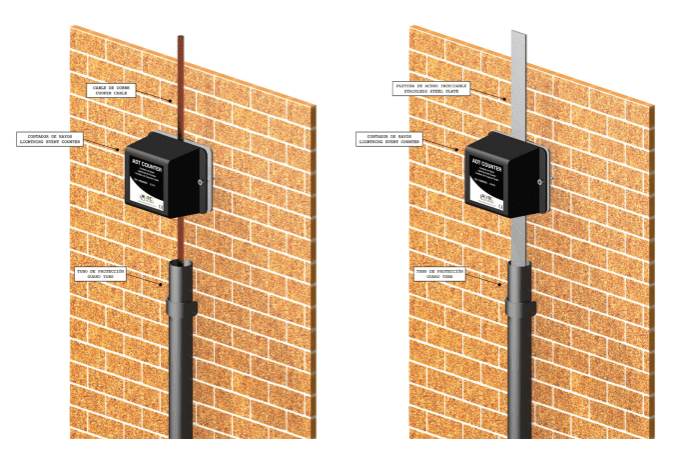
INSTALLING SURGE PROTECTORS
SPU equipment (unified protection systems) are specially designed for the protection of DATA CENTERS.
SPU protection equipment is characterized by:
– Three or four protection steps, depending on models, coordinated to ensure the protection of the DATA CENTER.
- Transient overvoltage protection threshold closely matched to the rated voltage of the installation.
- 10 independent protection modes; F/F, F/TT, F/N, N/TT.
- High discharge capacity; up to 4,500kA (8/20us).
- High transient response speed.
By installing a SPU in the busbar or main electrical panel of the DATA CENTER we will be protecting all the lines hanging from it against overvoltages (F/F, F/TT, F/N, N/TT) and MF/AF harmonics (RFI filtering).
These protection systems are capable of dissipating a large amount of energy, and will eliminate any type of transient overvoltage (atmospheric discharges, maneuvers in electrical networks, starting and stopping of motors, voltage oscillations, voltage peaks originated inside the installations, inductions when lightning strikes the lightning rod, etc…) and peaks associated with micro-cuts coming from outside the installations generated by switching in the power distribution lines. In the same way, they will also filter medium and high frequency harmonics (RFI filter) generated by non-linear loads, such as variable speed drives, UPS, switched-mode power supplies, etc.
Thus, by installing this equipment we will avoid electrical faults in electronic cards, power supplies, UPS, electronic equipment, etc., in short, we will eliminate all faults caused by transient overvoltages and medium and high frequency harmonics.
Most commonly proposed equipment SP 4D-100

EXAMPLE INSTALLATION
 The model to be installed will depend on the nominal voltage, type of electrical network and power of the DATA CENTER.
The model to be installed will depend on the nominal voltage, type of electrical network and power of the DATA CENTER.
INSTALLATION MODE SPU SERIES

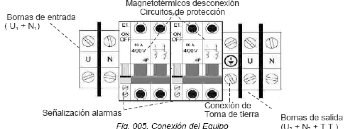
INSTALLATION MODE PARALLEL SPU

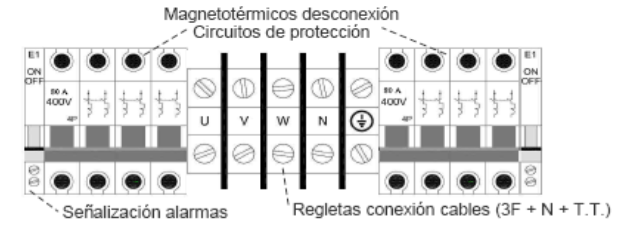
Equipotentialization is the process of bringing all surfaces to the same potential by bonding them together with conductors. Effective bonding and grounding is very essential to ensure shielding effectiveness. All metallic components within the data center, including signal reference grids on each floor, shielding systems, raised floors, cabinets, cable ducts, etc., must be bonded by equipotential bonding and connected to common ground, preferably with spark gaps.
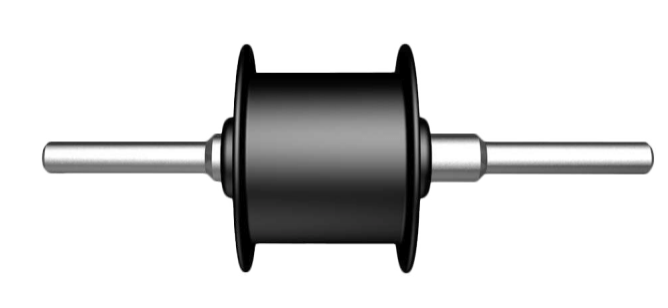
Grounding of data center switchboards
Generally, data centers have conventional grounding systems for all their equipment. But it is recommended to ground the data center racks and cabinet separately. This can help minimize the effects of voltage surges and related damage. Data center cabinets and racks can be connected using jumpers, nut and bolt connections with paint piercing washers, etc. to make electrically continuous joints and ground them.
Data center grounding can be easily understood at different levels, starting with the first level, including the cabinets and racks that are bonded, the second level, which includes the various equipment including servers, power systems, HVAC control systems, other hardware, etc. Then comes the signal reference grids or floor ground, then there is the containment ground which consists of each component being connected to the equipotential bonding bars.
Soil resistivity
Soil resistivity is always the main factor considered when designing and testing the grounding system of any installation. It is the basis for the design of the electrical grounding system and is important to eliminate any errors in soil resistivity testing. The final soil resistivity of data centers should be less than 1 ohm. Ground enhancers such as WELCONDUCTOR are used to reach the optimum values.
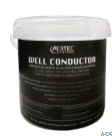 For all these reasons it is critical to be protected, lightning protection, grounding and SPU equipment installations are critical to data center operation.
For all these reasons it is critical to be protected, lightning protection, grounding and SPU equipment installations are critical to data center operation.
If you are working on a data center project, contact us for help with lightning and surge protection design.

